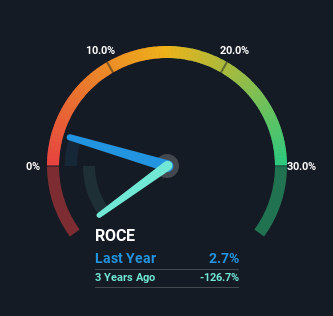- Malaysia
- /
- Metals and Mining
- /
- KLSE:AUMAS
The Returns On Capital At Bahvest Resources Berhad (KLSE:BAHVEST) Don't Inspire Confidence
When researching a stock for investment, what can tell us that the company is in decline? More often than not, we'll see a declining return on capital employed (ROCE) and a declining amount of capital employed. This combination can tell you that not only is the company investing less, it's earning less on what it does invest. And from a first read, things don't look too good at Bahvest Resources Berhad (KLSE:BAHVEST), so let's see why.
Return On Capital Employed (ROCE): What Is It?
For those who don't know, ROCE is a measure of a company's yearly pre-tax profit (its return), relative to the capital employed in the business. To calculate this metric for Bahvest Resources Berhad, this is the formula:
Return on Capital Employed = Earnings Before Interest and Tax (EBIT) ÷ (Total Assets - Current Liabilities)
0.027 = RM3.8m ÷ (RM172m - RM34m) (Based on the trailing twelve months to September 2023).
Thus, Bahvest Resources Berhad has an ROCE of 2.7%. Ultimately, that's a low return and it under-performs the Metals and Mining industry average of 6.1%.
View our latest analysis for Bahvest Resources Berhad

While the past is not representative of the future, it can be helpful to know how a company has performed historically, which is why we have this chart above. If you'd like to look at how Bahvest Resources Berhad has performed in the past in other metrics, you can view this free graph of Bahvest Resources Berhad's past earnings, revenue and cash flow.
The Trend Of ROCE
We are a bit anxious about the trends of ROCE at Bahvest Resources Berhad. To be more specific, today's ROCE was 24% five years ago but has since fallen to 2.7%. In addition to that, Bahvest Resources Berhad is now employing 59% less capital than it was five years ago. The combination of lower ROCE and less capital employed can indicate that a business is likely to be facing some competitive headwinds or seeing an erosion to its moat. Typically businesses that exhibit these characteristics aren't the ones that tend to multiply over the long term, because statistically speaking, they've already gone through the growth phase of their life cycle.
While on the subject, we noticed that the ratio of current liabilities to total assets has risen to 20%, which has impacted the ROCE. If current liabilities hadn't increased as much as they did, the ROCE could actually be even lower. While the ratio isn't currently too high, it's worth keeping an eye on this because if it gets particularly high, the business could then face some new elements of risk.
Our Take On Bahvest Resources Berhad's ROCE
In short, lower returns and decreasing amounts capital employed in the business doesn't fill us with confidence. Investors must expect better things on the horizon though because the stock has risen 9.7% in the last five years. Regardless, we don't like the trends as they are and if they persist, we think you might find better investments elsewhere.
One more thing, we've spotted 5 warning signs facing Bahvest Resources Berhad that you might find interesting.
While Bahvest Resources Berhad may not currently earn the highest returns, we've compiled a list of companies that currently earn more than 25% return on equity. Check out this free list here.
New: Manage All Your Stock Portfolios in One Place
We've created the ultimate portfolio companion for stock investors, and it's free.
• Connect an unlimited number of Portfolios and see your total in one currency
• Be alerted to new Warning Signs or Risks via email or mobile
• Track the Fair Value of your stocks
Have feedback on this article? Concerned about the content? Get in touch with us directly. Alternatively, email editorial-team (at) simplywallst.com.
This article by Simply Wall St is general in nature. We provide commentary based on historical data and analyst forecasts only using an unbiased methodology and our articles are not intended to be financial advice. It does not constitute a recommendation to buy or sell any stock, and does not take account of your objectives, or your financial situation. We aim to bring you long-term focused analysis driven by fundamental data. Note that our analysis may not factor in the latest price-sensitive company announcements or qualitative material. Simply Wall St has no position in any stocks mentioned.
About KLSE:AUMAS
AuMas Resources Berhad
An investment holding company, engages in gold mining business in Malaysia.
Flawless balance sheet with questionable track record.
Market Insights
Community Narratives



